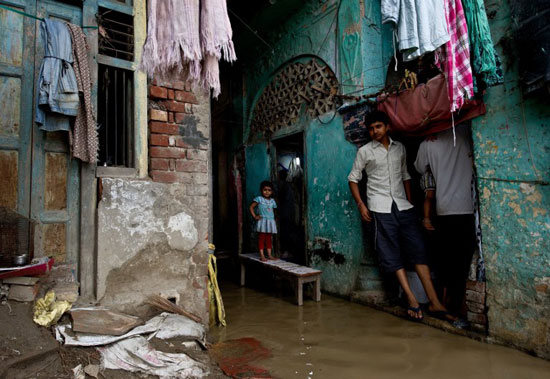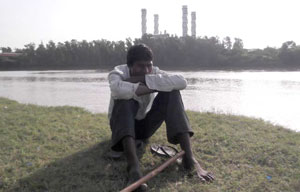
By Alankar, researcher at Sarai / STEPS Uncertainty from Below project.
The megacities of India like Delhi and Mumbai are exhibiting today what we can call ‘urbanization of poverty’ and ‘urbanization of consumption’.
More than half of the populations of both cities survives under acute poverty. At the same time, both these megacities today house the most upwardly-mobile sections of India’s middle class and elite. Resources like water and land, consumables like energy, transportation, buildings, goods and services are highly disproportionately divided among rich and poor. The resultant pollution, overuse, depletion and exploitation of life-sustaining resources – water, green space and so on – are also contributed to very differently by these cities’ varied populations.
The geographies of these cities, along with new patterns of climate change and consumption, are provoking new uncertainties for the people who live in them.
Water and the city
Like many other cities, Delhi and Mumbai’s urban growth owes much to physical geography. Delhi has a unique position at the confluence of the river Yamuna and extension of the Aravali Forest Ridge. For Mumbai, it was the natural creeks with dense mangroves around the seven islands, along with small rivers flowing among them, which helped to create the city we see today. Among many other things, certainties about weather patterns and climatic features helped to evolve the urban ecologies of both megacities.
Now, though, greenhouse gas emissions are gradually stoking climate change across the world. Megacities like Delhi and Mumbai of developing countries like India are highly vulnerable to the ensuing climatic disorder. Such cities are already experiencing multiple effects. On the one hand these cities are turning into urban heat islands due to their highly concretised landscape, where heat gets trapped. Furthermore, their natural green spaces – like Delhi’s ridge forest and Mumbai’s mangrove creeks, which help to absorb the heat – are slowly encroached upon by urban ‘desires’. Massively populated slums in both cities are constantly exposed to the dangers of flooding from more and more unpredictable rainfall, not to mention the expanding cycles of seasonal epidemics like dengue fever, typhoid, cholera, chikungunya etc.
 The energy-guzzling nature of India’s megacities is best exemplified by their transport systems and built environments. Rapidly-growing private motorized transport and electricity usage in city buildings are almost totally dependent on fossil fuel based supplies, adding to the cities’ contributions to greenhouse gases. Delhi’s river Yamuna and Mumbai’s Mithi, choked with untreated sewage, are of scant value today as drinking water sources. Both cities are expanding their ecological footprints by drawing water from distant sources. The landfill sites of both Delhi and Mumbai have long ago exceeded their limits and today have transformed into mountains of solid waste, constantly emitting methane, a powerful greenhouse gas.
The energy-guzzling nature of India’s megacities is best exemplified by their transport systems and built environments. Rapidly-growing private motorized transport and electricity usage in city buildings are almost totally dependent on fossil fuel based supplies, adding to the cities’ contributions to greenhouse gases. Delhi’s river Yamuna and Mumbai’s Mithi, choked with untreated sewage, are of scant value today as drinking water sources. Both cities are expanding their ecological footprints by drawing water from distant sources. The landfill sites of both Delhi and Mumbai have long ago exceeded their limits and today have transformed into mountains of solid waste, constantly emitting methane, a powerful greenhouse gas.
What does it mean to tackle climate change?
Urban India, then, needs to scale up its efforts both in adapting to climate change and mitigating the causes of global warming.
The certainty of this serious requirement is faced with multifaceted uncertainties. Successful mitigation would require fundamental scaling down of the lifestyle of the rich and middle classes, whereas adaptation is the key to make cities resilient against climatic change in favour of the most vulnerable poor. Will the political economy of economic growth-based development become inclusive for all urban residents in future, or will it continue to widen the gap between rich and poor?
And within the matrix of a globalised world economy, what is the scope for Indian cities with their own complexities to develop an economic paradigm which would turn them sustainable ecologically? The Government of Delhi and the Municipal Corporation of Mumbai, in their efforts to deal with climate change, are mostly inclined towards raising awareness, developing partnerships with the private sector, publicising technological shifts towards climate sensitive usage of materials and machines, and encouraging behavioural changes towards the three Rs (reduce, reuse, recycle). Whether state- and market-led initiatives will be able to deal with global warming induced climate change, is as crucial an institutional uncertainty as climate change itself.
Climate, knowledge and media
Increasing climatic uncertainty is also bringing forth our uncertainties about what we know. Which way(s) to deal with climate change are getting prioritized by the key policy/ decision makers? Why? What kind of assessments are becoming the driving forces? The tackling of the issue of global warming is so expert-driven that democratic or consensual ways of looking at it are often put aside. Expertise to resolve such a complex issue is such a given today that even gauging its impacts on vast numbers of people is being left to be pursued by professionals.
The growth of the media is today strongly attached to increasing consumption of goods, products and services within society. Such increasing consumptive patterns, changing people from citizens to consumers, fuel not just the media, but also the way economies are modelled nationally and internationally. Consumption is entrenched within the global warming context. Urbanization is a key constituent in increased consumption. Can urbanization and consumption be ‘decoupled’ in a way that might tackle climate change, and could the media play a role?
Since 2007 more than half of the world’s population has moved into cities. This growing phenomenon is distinctly related to global warming. What type of urbanism is going to prevail, especially in developing countries, will shape the lives of people and our planet. And there seem huge uncertainties about this trajectory.
This post is a slightly edited version of an article which first appeared in Southasiadisasters.net, republished with kind permission.
Photos:
- India weather – Monsoon, Yamuna by Diarocritico de Venezuela on Flickr (cc-by 2.0)
- Power plants by the Yamuna (STEPS Centre)